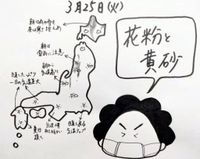On March 25, 2025, cities across Japan are preparing for yellow sand events that will affect visibility and potentially disrupt daily activities. The phenomenon, which arises from dust storms in East Asian regions, is expected to blanket large areas from northern to western Japan over the next two days. On this day, meteorological observatories have already recorded significant weather impacts, with unusual visibility restrictions being reported.
The Fukuoka Meteorological Observatory announced that yellow sand was observed in Fukuoka City, warning residents about poor air quality and the risk of health complications. It is anticipated that visibility would drop to under 10 kilometers, and in some spots, possibly even below 5 kilometers. As a precaution, officials are advising individuals to wear masks when venturing outdoors. The Ministry of the Environment highlighted that such conditions can exacerbate respiratory issues and allergy symptoms.
In Osaka, similar alerts have been issued, where an 8-kilometer visibility was recorded as of 9:00 AM on March 25. This marks the first observation of yellow sand for the year, with expectations of continued weather disturbances across the region. According to the Japan Meteorological Agency, this weather situation is likely to lead to traffic obstructions as low visibility hampers transportation.
Forecaster Tenki Kubota took to social media to inform the public about the ongoing yellow sand and pollen impacts. His updates on Instagram provided valuable insights into national weather patterns, noting that while Hokkaido experienced rain and snow in the morning, regions in eastern and western Japan enjoyed what could be described as early summer weather. However, he didn’t shy away from addressing the potential health implications of yellow sand combined with pollen, urging the need for vigilance in managing symptoms.
“We should be cautious about combined exposures,” Kubota stated. His comments resonated with many social media users who shared their concerns about managing laundry and keeping conditions at home safe during this unpredictable weather.
The phenomenon of yellow sand, often observed during spring in Japan, is caused by strong winds that lift sand from desert regions in East Asia, carrying it over countries like Japan. Local experts emphasize the importance of monitoring such weather events, especially as they can lead to significant nuisances including reduced visibility for drivers and increased health risks for individuals with pre-existing respiratory conditions.
As forecasters predict the yellow sand will persist through March 26, residents are urged to remain informed and prepared for ongoing changes in weather conditions. This includes taking necessary health precautions and adjusting travel plans where necessary. Officials are continuing to monitor the situation closely, and updates will follow as conditions develop.
Overall, Japan is witnessing a weather event that highlights not only the influence of climatic conditions on everyday life but also the intersections of health and nature that the population must strategically navigate. The upcoming days will be a true test of resilience for many as they cope with the dual challenges of yellow sand and pollen.
This year's events serve as a reminder of the continuing relevance of public health advisories and the importance of staying engaged with weather forecasts, especially during transitional seasons.







